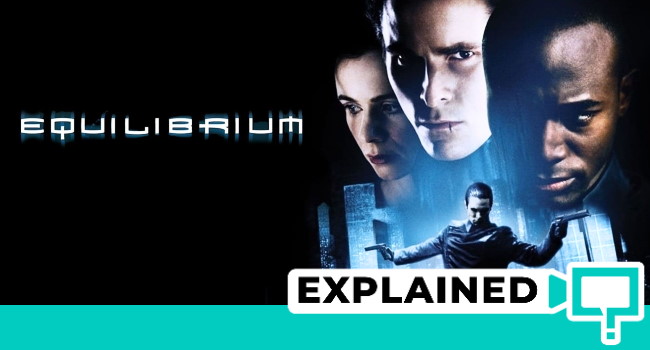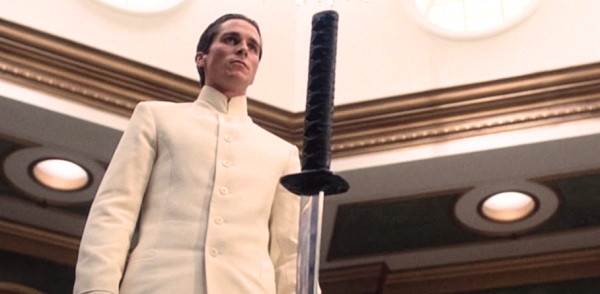Nineteen Eighty-Four mixed with futuristic elements, gun kata, and Matrix-esque aesthetics—Kurt Wimmer recreates an enthralling blend in his action-thriller Equilibrium, released in 2002. The story unfolds in a dystopian future where a post-WWIII world falls into tyranny and totalitarianism. Libria, a new state ruled by Father, makes all sorts of emotions illegal, just like the things that can evoke them, like art or music. The movie focuses on John Preston, a high-ranking Grammaton Cleric, who is supposed to enforce the regime but starts to feel. Here’s the plot of the movie Equilibrium explained; spoilers ahead.
Hollywordle – Check out my new Hollywood Wordle game!
Where To Watch?
To find where to stream any movie or series based on your country, use This Is Barry’s Where To Watch.
Oh, and if this article doesn’t answer all of your questions, drop me a comment or an FB chat message, and I’ll get you the answer. You can find other film explanations using the search option on top of the site.
Contents
Here are links to the key aspects of the movie:
- – Who Is Errol Partridge?
- – Who Is John Preston?
- – What Is Prozium II?
- – Mechanization of Society
- – The Role of Viviana Preston
- – Manifestations of Preston’s Emotions
- – What Is the Significance of Mary O’Brien?
- – Who Is Father? Does He Feel?
- – Ending Explained
Who Is Errol Partridge?
Equilibrium starts with a Cleric raid against the Underground, a resistance movement. Preston, together with his partner Partridge, destroys illegal artworks and books, except Errol casually saves one, The Poetry of William Butler Yeats. This is when we understand that he feels.
Preston executes his partner for a sense crime a few moments later when he finds him reading the book in an abandoned church. In his last moments, Partridge reads him one of the poems and then raises the book to shield himself. According to an analysis by a top paper writer from essay help service, an academic writing platform for students, Partridge uses literature as his last weapon. He stands by his beliefs and is ready to die for them. The last lines he says are from a poem:
I would spread the cloths under your feet:
But I, being poor, have only my dreams;
I have spread my dreams under your feet;
Tread softly because you tread on my dreams.
These words will appear in the movie again, just like Preston will parallel the identical scene with Partridge as he takes a book from a different raid, this time for himself. Partridge’s willingness to die for his ideas is a turning point in Preston’s development.
Who Is John Preston?
The story doesn’t tell us much about Preston’s background. Actually, he isn’t even supposed to have one. His life is his service. Preston is a Grammaton Cleric, an elite law enforcement order that does clean-up raids to eliminate any manifestations of emotions in Libria.
Preston is the best at it. He’s a perfect soldier of the Tetragrammaton Council who can tell when a person starts to feel emotions and makes no mistakes. Paradoxically, his steel-like self-control and mastery in serving the regime are the things that destroy it.
The decision to feel emotion is a choice for Preston. It’s obviously easier to live without them. But this ease and comfort also means the loss of freedom and human rights. The regime sets the rules, but a person decides if they want to play by them. It’s a choice – either to be complicit and give up on your humanity or to fight for things you believe in and demand justice. In this sense, Equilibrium mirrors real-life totalitarianism versus a society that is willing (or not) to resist.
What Is Prozium II?
The devastation and destruction caused by the Third World War served as an excuse for the ruling regime of Libria to ban all human emotions. A psychoactive drug Prozium II should be self-administered by all citizens to prevent this cause of human violence and hatred against each other.
Naturally, alongside erasing anger, fear, and sadness, it wipes away happiness and compassion. People become incapable of love or friendship. The only aim of their lives is blind servitude to the state. By claiming to end wars, the regime declares war on its people and their human nature.
Mechanization of Society in Equilibrium
The goal of the regime in Equilibrium is to turn people into machines, incapable of emotions that can drive them to protest against the ideology imposed by the government. This mechanization of the human mind and body is used as a tool. Without emotions, people become alienated from each other and easier to be manipulated. While the feeling of absolute peace and “equilibrium” might be desired, it deprives people of feelings of what it means to be alive.
All people in Libria look the same. They wear emotionless expressions and plain dark uniforms that make them similar to living robots. They stop being subjects. With no inner life, no wants, and no affections, citizens of Libria are “something,” not “someone.”
What Is the Mise-en-Scene of Equilibrium?
The mise-en-scene of Equilibrium is filled with codes and meanings. At the beginning of the movie, we see Preston with his partner Partridge during one of their raids against the resistance. The setting shows destroyed and abandoned buildings where the resistance members try to hide the remnants of the normal world: books, paintings, record players, and small knick-knacks that have some style and color to them.
Yet, the goal of the regime is to destroy anything that may make a person feel. We see the Mona Lisa, a masterpiece of the Renaissance, hidden under the floorboards. At this point, even the rhythm of the movie slows down as the portrait gets destroyed in flames, and Mona Lisa smiles through it as a symbol of indestructible hope.
Another metaphorical code is a deserted church. The symbol of faith and protection is no longer safe or sacred. The fact that this is the place where Preston kills his partner shows the complete degradation and dehumanization of society.
Kurt Wimmer uses setting, colors, and arrangement of objects to communicate senses. While the resistance holds on to things like antique mirror frames and photos that are outlawed, the setting of offices, streets, and residential buildings in Libria are all the same. Everything looks sterile, devoid of any personality. The colors are so desaturated the film seems almost black-and-white. The composition is strictly symmetric, based on right angles and uniform placement of objects within the frame of a shot. This conveys the sense of conformity, sameness, and total control that reigns in Libria.
The Role of Viviana Preston
The episode where DuPond questions Preston on the arrest of his wife proves that he has been experiencing emotions long before discontinuing Prozium injections. Again, the movie uses the language of light and color to convey their love for each other.
When DuPont reminds Preston of Viviana, the scene gets interrupted by a contrasting flashback. Here the woman gets arrested as a sense offender. What is peculiar about this episode is that her sole presence makes the world more colorful and bright in his memory. It shows that despite oppression, Preston was capable of love. Although he couldn’t openly mourn the loss of Viviana because his emotions were suppressed by Prozium, this tragedy unconsciously triggered him to start questioning his beliefs.
Manifestations of Preston’s Emotions
The real transformation for Preston starts when he drops a vial with his injection and misses a shot. He starts to see dreams and experience sensations. Preston needs to rediscover beauty for himself. The character breaks a film on his window and sees a rainbow and rising sun for the first time in years. When heading to work, he removes his glow to experience the world by touch. Even the sensation of a stair railing under his hand feels new and exciting.
Without drugs, Preston starts to notice oppression even in little things. Objects on his colleagues’ desks are the same and placed in the same spots on every desk of every Cleric. Rearranging stationery on his desk is a way for Preston to protest.
What Is the Significance of Mary O’Brien?
One of the pivotal moments of the movie happens when Preston meets Mary O’Brien. Just like his wife Viviana, she is a sense offender, and just like her, she is to be executed or “processed” in the language of the Tetragrammaton Council. Mary stirs up Preston’s emotions. During interrogations, she challenges his beliefs, asking what he lives for and if he knows what a friend is.
However, the role of Mary in Preston’s life is much greater. Her appearance in his life is his second chance: to love and do the right thing. He tries to save Mary and stop the execution, something he didn’t do for Viviana. Even though it’s too late, with Mary’s ribbon in his hand, Preston turns from evil to righteous.
Equilibrium Movie: Who Is Father? Does He Feel?
As is typical in totalitarian regimes, a great leader is no more than an image. Father is fiction, a God-life figure created by propaganda. Being long dead, his image was used to spread manipulation through the screens with his propaganda all around Libria.
The power, however, is concentrated in the hands of a very real person. DuPont, a vice-counsel of Father, is full of hatred, anger, and self-indulgence. He is a typical symbol of the totalitarian elite. Someone who spreads false ideas only seeking power and control.
The setting plays an important role in understanding DuPont as well. While the whole of Libria is condemned to be a dark and colorless place, his office has bright walls, heavy red curtains, artworks, Tuscan columns, and antique furniture. He feels emotions and indulges in every forbidden luxury.
Equilibrium Movie: Ending Explained
The ending of the movie Equilibrium reveals that DuPont is now Father and he has tricked Preston into exposing the Underground. Preston battles and kills Brandt and goes after DuPont. In the finale, Preston kills DuPont and exposes Father’s propaganda. With the Prozium plants destroyed, the world will feel once again. While the film ends on a positive note, humans are going to be humans and eventually go to war with each other.
Equilibrium Movie: Final Thoughts
Equilibrium received rather mixed reviews from the critics. Some criticize it for heavy reliance on other dystopian works and a lack of original message. But as Roger Ebert noted, it “would be a mindless action picture, except that it has a mind.” Its complex characters and mise-en-scene convey a strong message.
Besides, as the real world faces a crisis upon crisis, dystopian movies like Equilibrium acquire new senses and become more relevant. Although rather underrated, the film is well-worth seeing. It is action-packed, symbolic, and gives you another chance to enjoy an exceptional performance of Christian Bale.
What were your thoughts on the plot and ending of the movie Equilibrium? Leave a comment below!

Barry is a technologist who helps start-ups build successful products. His love for movies and production has led him to write his well-received film explanation and analysis articles to help everyone appreciate the films better. He’s regularly available for a chat conversation on his website and consults on storyboarding from time to time.
Click to browse all his film articles


